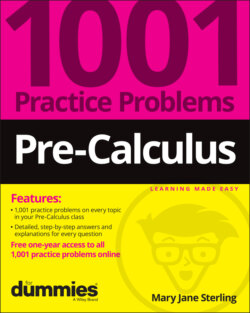Читать книгу Pre-Calculus: 1001 Practice Problems For Dummies (+ Free Online Practice) - Mary Jane Sterling, Mary Sterling Jane - Страница 10
ОглавлениеChapter 3
Function Basics
A function is a special type of rule or relationship. The difference between a function and a relation is that a function has exactly one output value (from the range) for every input value (from the domain). Functions are very useful when you’re describing trends in business, heights of objects shot from a cannon, times required to complete a task, and so on. Functions have some special properties and operations that allow for investigation into what happens when you change the rule.
The Problems You’ll Work On
In this chapter, you’ll work with functions and function operations in the following ways:
Writing and using function notation
Determining the domain and range of different types of functions
Recognizing even and odd functions
Checking on whether a function is one-to-one
Finding inverses of one-to-one functions
Performing the basic operations on functions and function rules
Working with the composition of functions and the difference quotient
What to Watch Out For
Don’t let common mistakes trip you up; keep in mind that when working with functions, your challenges will include
Following the order of operations when evaluating functions
Determining which values need to be excluded from a function’s domain
Working with negative signs correctly when checking for even and odd functions
Being sure a function is one-to-one before trying to determine an inverse
Correctly applying function rules when performing function composition
Raising binomials to higher powers and including all the terms
Using Function Notation to Evaluate Function Values
121−125 Evaluate the function for the given value.
121. Given , find .
122. Given , find .
123. Given , find .
124. Given , find .
125. Given , find .
Determining the Domain and Range of a Function
126−135 Find the domain and range for the function.
126.
127.
Illustration by Thomson Digital
128.
129.
130.
131.
132.
133.
134.
135.
Recognizing Even Functions
136−137 Determine which function is even.
136. , , , ,
137. , , , ,
Identifying Odd Functions
138−139 Determine which function is odd.
138. , , , ,
139. , , , ,
Ruling Out Even and Odd Functions
140 Determine which function is neither even nor odd.
140. , , , ,
Recognizing One-to-One Functions from Given Relations
141−143 Determine which of the given relations is a one-to-one function over its domain.
141. , ,
142. ,,,,
143.
Illustration by Thomson Digital
Illustration by Thomson Digital
Illustration by Thomson Digital
Illustration by Thomson Digital
Illustration by Thomson Digital
Identifying One-to-One Functions from Equations
144−145 Determine which of the functions is one-to-one over its domain.
144. , , , ,
145. , , , ,
Recognizing a Function’s Inverse
146−150 Determine which pair of functions are inverses of each other.
146. ,,,,
147. ,,,,
148. , ,,
149. , ,,,
150. ,,,
Determining a Function’s Inverse
151−160 Find the inverse of the function.
151.
152.
153.
154.
155.
156.
157.
158.
159.
160.
Executing Operations on Functions
161−165 Perform the indicated operation using the given functions.
161.
Find .
162.
Find .
163.
Find .
164.
Find .
165.
Find .
Performing Function Composition
166−169 Find .
166.
167.
168.
169.
Doing More Function Composition
170−176 Perform the indicated operation.
170.
Find .
171.
Find .
172.
Find .
173.
Find .
174.
Find .
175.
Find .
176.
Find .
Using the Difference Quotient
177−180 Evaluate the difference quotient, , for the given function Assume .
177.
178.
179.
180.
